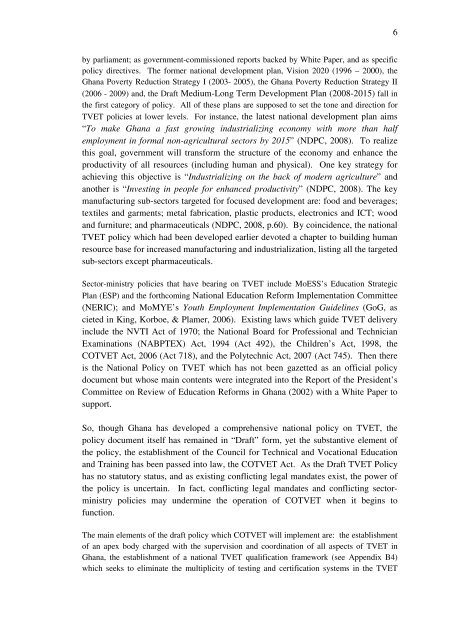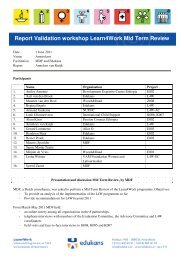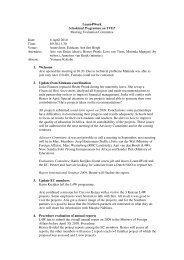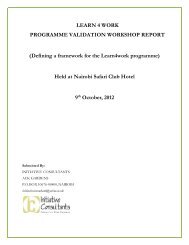DRAFT TECHNICAL AND VOCATIONAL EDUCATION AND ...
DRAFT TECHNICAL AND VOCATIONAL EDUCATION AND ...
DRAFT TECHNICAL AND VOCATIONAL EDUCATION AND ...
Create successful ePaper yourself
Turn your PDF publications into a flip-book with our unique Google optimized e-Paper software.
6<br />
by parliament; as government-commissioned reports backed by White Paper, and as specific<br />
policy directives. The former national development plan, Vision 2020 (1996 – 2000), the<br />
Ghana Poverty Reduction Strategy I (2003- 2005), the Ghana Poverty Reduction Strategy II<br />
(2006 - 2009) and, the Draft Medium-Long Term Development Plan (2008-2015) fall in<br />
the first category of policy. All of these plans are supposed to set the tone and direction for<br />
TVET policies at lower levels. For instance, the latest national development plan aims<br />
“To make Ghana a fast growing industrializing economy with more than half<br />
employment in formal non-agricultural sectors by 2015” (NDPC, 2008). To realize<br />
this goal, government will transform the structure of the economy and enhance the<br />
productivity of all resources (including human and physical). One key strategy for<br />
achieving this objective is “Industrializing on the back of modern agriculture” and<br />
another is “Investing in people for enhanced productivity” (NDPC, 2008). The key<br />
manufacturing sub-sectors targeted for focused development are: food and beverages;<br />
textiles and garments; metal fabrication, plastic products, electronics and ICT; wood<br />
and furniture; and pharmaceuticals (NDPC, 2008, p.60). By coincidence, the national<br />
TVET policy which had been developed earlier devoted a chapter to building human<br />
resource base for increased manufacturing and industrialization, listing all the targeted<br />
sub-sectors except pharmaceuticals.<br />
Sector-ministry policies that have bearing on TVET include MoESS’s Education Strategic<br />
Plan (ESP) and the forthcoming National Education Reform Implementation Committee<br />
(NERIC); and MoMYE’s Youth Employment Implementation Guidelines (GoG, as<br />
cieted in King, Korboe, & Plamer, 2006). Existing laws which guide TVET delivery<br />
include the NVTI Act of 1970; the National Board for Professional and Technician<br />
Examinations (NABPTEX) Act, 1994 (Act 492), the Children’s Act, 1998, the<br />
COTVET Act, 2006 (Act 718), and the Polytechnic Act, 2007 (Act 745). Then there<br />
is the National Policy on TVET which has not been gazetted as an official policy<br />
document but whose main contents were integrated into the Report of the President’s<br />
Committee on Review of Education Reforms in Ghana (2002) with a White Paper to<br />
support.<br />
So, though Ghana has developed a comprehensive national policy on TVET, the<br />
policy document itself has remained in “Draft” form, yet the substantive element of<br />
the policy, the establishment of the Council for Technical and Vocational Education<br />
and Training has been passed into law, the COTVET Act. As the Draft TVET Policy<br />
has no statutory status, and as existing conflicting legal mandates exist, the power of<br />
the policy is uncertain. In fact, conflicting legal mandates and conflicting sectorministry<br />
policies may undermine the operation of COTVET when it begins to<br />
function.<br />
The main elements of the draft policy which COTVET will implement are: the establishment<br />
of an apex body charged with the supervision and coordination of all aspects of TVET in<br />
Ghana, the establishment of a national TVET qualification framework (see Appendix B4)<br />
which seeks to eliminate the multiplicity of testing and certification systems in the TVET







